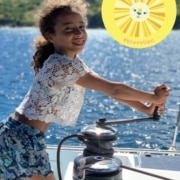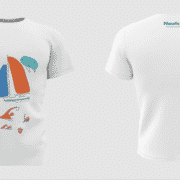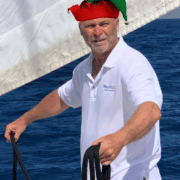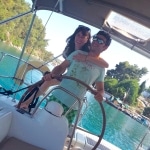Childhood Cancer and Youth Sailing
September is Childhood Cancer Month
NauticEd’s Support of Childhood Brain Cancer Works to Help Kids Worldwide

Childhood brain cancer became a nightmare reality in February 2021 to the family of Grant Headifen, owner and founder of NauticEd International Sailing Education. “We were just about to launch our Youth Sailing program when the devastating MRI results came in”, says Headifen. He says the Youth program is still going ahead but will be a little delayed while dealing with his 13-year-old daughter’s condition. What will be a little different now with NauticEd Youth is that 100% of the Youth profits will go towards fighting childhood brain cancer. NauticEd Youth will carry the mantra “Kid’s should be going sailing NOT going through brain cancer”.
The diagnosis of DIPG (Diffuse Intrinsic Pontine Glioma) is completely shattering once you can gather enough breaths after diagnosis to learn what it is. Mutated cancer cells wrap around the brainstem and grow into an inoperable tumor with a quick and worst possible result. Until now, no drug has been effective. On Feb 22nd, 2021, Headifen was told the news after taking his daughter in for a MRI to check on her slight dizziness condition, eyesight changes, and headaches. He was told there was no cure – to go home and make memories!
13 years ago, people told Headifen he could not build the biggest and best sailing education company in North America and beat out the incumbents. Yet, that is what he has done with NauticEd now leading the way in 21st century sailing education with over 250,000 courses delivered to students in 90 different countries and a growing network of practical sailing instructors. Prior to that people said he could not build the best sailing fractional share company – he did!
AND, telling him there is no cure for a child – to go home and make memories is NOT going to happen on his watch. Headifen’s family quickly got to work with a massive amount of research and hundreds of phone calls to his network of friends and contacts. What came out was a plan – a solid plan. One involving science and an arduous ongoing life-changing journey and one that leads us to ask to help fund research into Childhood cancer.


Here is Headifen’s blow-by-blow account of the journey so far.
Part 1 – Week 1 – Gain control of the situation
We put her on small amount of Dexamethazone (steroid) to control the swelling while we quickly took her to Texas Children’s Hospital in Houston where they performed a biopsy into her brain using a robot to determine the type of DIPG (yes there are multiple types). During the same procedure, she was given a shunt which is a tube down into a brain ventricle then out and under her skin all the way to a cavity in her stomach area. This allows any swelling to reduce headaches and take pressure off the brain via a fluid drain. “The robot biopsy is a risky procedure” – so they say – right before you sign the paperwork for approval. But the risk is moot when the severity of what is facing you is considered.
Part 2 – Week 3 – Week 9 Start Treatment and search for courseal trials
The only effective treatment for DIPG is photon radiation because of the tumor’s diffuse nature. This was a daily zapping every day of the week with weekends off. This went on for a total of 36 treatments. She was going further downhill fast but turned around at about the 3-week mark after the start of radiation. She started feeling better each day thereafter.
We also did a series of 50-minute long hyperbaric chamber treatments at 1.75 atm towards the end of the radiation treatment. The theory there was to load the cancer cells up with oxygen then race in hte car over to radiation treatment to use the photon radiation to hit the engorged cancer cells harder. In the meantime, we used a series of supplements to her diet – including Curcumin, Boswellia (Frankincense), CBD and THC, which all have known cancer arresting properties. The plan here was to slow the cancer as much as possible. We tried a Keto diet but for a 12-year-old at the time she was losing weight fast – we needed her to keep up her strength and body weight for the coming battle. For a time, we also followed the Care Oncology protocol which is an empirically proven treatment for slowing cancer with some decent science attached to reduce the ability of the cancer to access glucose – similar thinking to the Keto diet. We were learning science words and bio-chemical reactions faster than we could think.
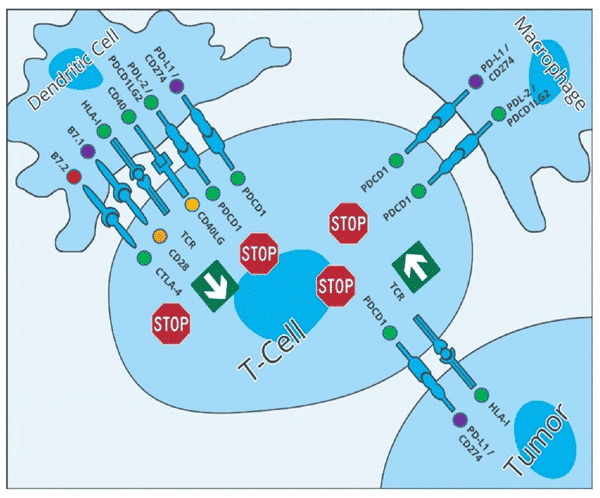
From the start, I was convinced that an immunotherapy treatment had the highest chance of cure and remission and so the focus of the search was narrowed. Three candidate trials were found: Texas Children’s, Stanford’s Lucille Packard, and Seattle Children’s. The choice was tough because of the stella reputation of each. Finally, Stanford was chosen because at the time they had the most experience in dealing with the type of DIPG – H3.3K27M mutation which is the most aggressive of all the DIPG’s.
The Science behind the immunotherapy treatment. On all H3K27M mutations, a protein exists on the cell wall named GD2. What the scientists figured out is how to modify a T cell and train it to look for GD2 protein and when it finds it – KILL the cell it is attached to. That’s it! The newly trained T cell is called a CAR T cell (Chimeric Antigen Receptor). So, the plan with the trial is to pull out a few hundred million T Cells, modify them to be CAR T cells then put them back into her body.
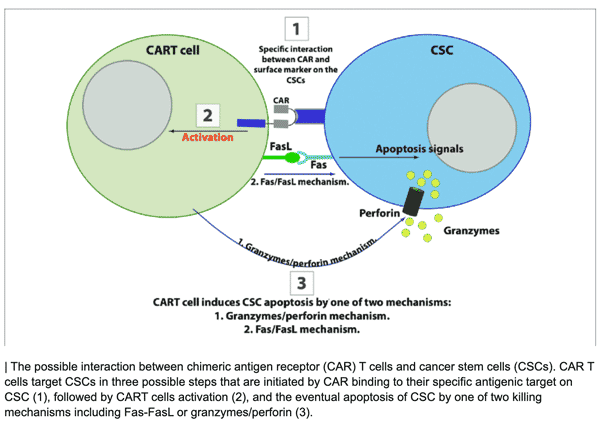
Part 3 – Week 9 – week 13 – Medical Trial Qualification
Each medical trial has a qualification criteria. My daughter’s was that the cancer could not have further metastasized into other areas of the brain which was to be measured at the 4-week period after Radiation Treatment had completed. That is a nail-biting and highly stressful month. We were fortunate – as fortunate as one can be. Her tumor had actually shrunk at the 4-week period. We could not be sure what exactly had caused any shrinking but attributed it to a combination of all things we had done so far. Maybe some stuff worked and others did not – who can say which. Also, a qualification for most all trials is that the patient has stopped other supplements and treatments prior to the trial. Because we were so certain of the upcoming CAR T cell immunotherapy science we followed the trial scientists’ lead and ended all supplements – more nail-biting.
Part 4 – Week 15 – Week 16 – Get Ready for the Trail
You get to learn new words that you don’t want to ever be in a position to learn. Apheresis is using a machine to filter out our own body’s T-cells from the blood. My daughter’s arteries were too small for the size of the needle they needed to effectively pull the blood out and push back into her body. They thus performed an operation to insert a rubber tube into her heart artery. Apheresis takes about 5 hours of watching the blood flow out, through a machine and back into her body.
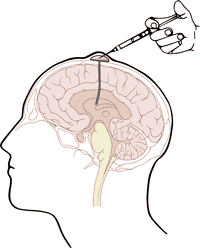
Modification of her original brain shunt was a required operation to add a Rickham Reservior so that they can eventually use the tube to insert the CAR T cells directly into her brain. She also had a surgical procedure to install a port under her skin in her right chest so that any required medicines could be given without doing an IV each time and blood draws can be done at will to monitor her body chemistry during and after the infusion of CAR T. The port has direct access to her heart artery so it’s not an insignificant surgery either.
Part 5 – Week 17 – 21 – Wait for the CAR T cells to grow
This is about a 2-3-weeklong process to grow and modify her T Cells into CAR T cells. All the while she was feeling pretty good – her symptoms as with most DIPG patients were that her eyes were becoming blurry and double visioned. But thankfully, her symptoms here holding – meaning not getting worse.
Part 6 – Week 22 – 26 – Infusion of the CAR T cells
This is the part where you get to watch the miracle of true science unfold in front of your own eyes. One of the measures of the CAR Ts working is her LDH levels in her blood. LDH is a semi-measure of cellular death “apoptosis”. A few days after infusion the LDH started climbing higher and higher – and even higher – meaning we were knocking the hell out of H3.3K27M. High LDH held high for about 10 days. All the while the Neuro Oncologists were watching for signs of courseal improvement. Within the first week, they were exclaiming “WOW” and by the end of 4 weeks after the infusion, my daughter’s eyes were almost returned to normal with still a bit of double vision around the edges. Additionally, the MRI showed a significant dissolving of the tumor at various layers of the MRI. The science held and is true. It works!
Part 7 – Post week 26 – Subsequent Infusions
As we write this, we now await the 2nd infusion of CAR T cells into her brain. We expect at least 5-10 infusions before we can say goodbye fully to old H3K27M and full remission. There is a small group of children right now going through the world’s first CAR T cell immunotherapy treatment trials of DIPG at Stanford’s Lucile Packard, Texas Children’s, and Seattle Children’s. These kids are pioneers – they are so brave to be leading this way and they deserve pioneer heroic status.
With science comes research and sacrifice, so there are many soldiers who have pathed the way including many kids no longer with us whose cells were donated for studies. For those kids and parents– there are no words to properly convey our condolences and incredible thanks at the same time. To the scientists – we thank you for your tireless journey. Solving Childhood cancer is truly a worthy cause. About 300 kids in the USA alone each year develop this family-destroying cancer. From above you can see that we moved incredibly fast and it was not until week 26 that we began to see any results – that’s 6 months of sheer hell. The stress on families of childhood cancer is horrific. We are fortunate in that we are two blended families meaning we had 4 parents able to work near full-time to get us to this point.
There are some others to thank along our journey which are: my daughter’s step mom, Lauren, who through tireless efforts did all the research and background advocacy for my daughter, the donors who contributed to my daughter’s treatment and travel costs, the entire NauticEd team who all stepped up the pace to help out and take up the slack while I was taking time off (to tell the truth the company probably grew better without me), family and friends, the meal train crew who arranged dinner deliveries to us for two months while we were performing research, the families who donated their vehicles to use and homes for us to stay in near Stanford, California, and countless others who continuously mailed my daughter letters and cards and lit candles in churches the four corners of the planet.
Part 8 and beyond – We are not giving up – Join Us
With this new hope for a science solution for DIPG, we at NauticEd plea to all parents to help fund Childhood cancer research. NauticEd has started the ball rolling with 100 % of profits from NauticEd Youth going to this research and has also put $15,000 into the pot as a kick off. During all sailing course purchases, NauticEd students will soon have the opportunity to round up their purchase a few bucks or more – to fund Childhood cancer research and cures.
Our initial funding campaign is being done through the 501c3 non-profit Arms Wide Open Childhood Cancer Foundation where 100% of the tax-deductible donation is given to Stanford Lucille Packard Children’s Hospital to fund continuing DIPG research and trials. It is imperative that this treatment is able to move quickly to become standard care and cure for DIPG as quickly as possible – it will truly save kids’ lives.
Please donate this September for Childhood Cancer month.




